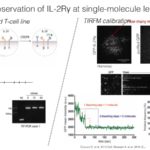Lien vers Pubmed [PMID] – 25517094
Nature 2015 Jan;517(7535):460-5
Endocytosis is required for internalization of micronutrients and turnover of membrane components. Endophilin has been assigned as a component of clathrin-mediated endocytosis. Here we show in mammalian cells that endophilin marks and controls a fast-acting tubulovesicular endocytic pathway that is independent of AP2 and clathrin, activated upon ligand binding to cargo receptors, inhibited by inhibitors of dynamin, Rac, phosphatidylinositol-3-OH kinase, PAK1 and actin polymerization, and activated upon Cdc42 inhibition. This pathway is prominent at the leading edges of cells where phosphatidylinositol-3,4-bisphosphate-produced by the dephosphorylation of phosphatidylinositol-3,4,5-triphosphate by SHIP1 and SHIP2-recruits lamellipodin, which in turn engages endophilin. This pathway mediates the ligand-triggered uptake of several G-protein-coupled receptors such as α2a- and β1-adrenergic, dopaminergic D3 and D4 receptors and muscarinic acetylcholine receptor 4, the receptor tyrosine kinases EGFR, HGFR, VEGFR, PDGFR, NGFR and IGF1R, as well as interleukin-2 receptor. We call this new endocytic route fast endophilin-mediated endocytosis (FEME).

